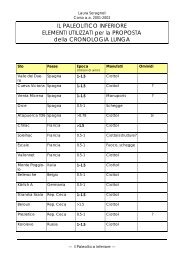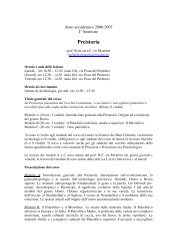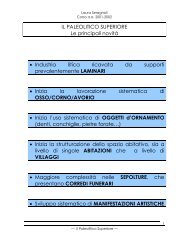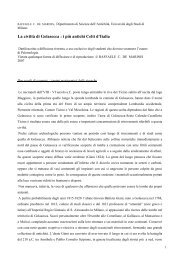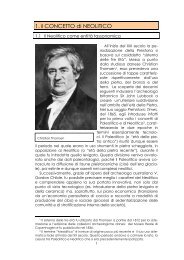Origine ed evoluzione del genere Homo - ArcheoServer
Origine ed evoluzione del genere Homo - ArcheoServer
Origine ed evoluzione del genere Homo - ArcheoServer
You also want an ePaper? Increase the reach of your titles
YUMPU automatically turns print PDFs into web optimized ePapers that Google loves.
3.7 Australopithecus africanus . . . . . . . . . . . . . . . . . . . . 75<br />
3.8 Le caverne di Sterkfontein . . . . . . . . . . . . . . . . . . . . 76<br />
3.9 Il <strong>genere</strong> Paranthropus (Australopiteco robusto) . . . . . . . . 81<br />
3.10 Australopithecus garhi . . . . . . . . . . . . . . . . . . . . . . 86<br />
3.11 Il significato evolutivo <strong>del</strong>la bip<strong>ed</strong>ia . . . . . . . . . . . . . . . 86<br />
3.12 Australopithecus / <strong>Homo</strong> habilis . . . . . . . . . . . . . . . . . 91<br />
4 L’<strong>Homo</strong> erectus 96<br />
4.1 <strong>Homo</strong> ergaster ovvero i più antichi <strong>Homo</strong> erectus africani . . . 97<br />
4.2 L’<strong>Homo</strong> erectus in Asia . . . . . . . . . . . . . . . . . . . . . . 100<br />
4.2.1 L’<strong>Homo</strong> erectus <strong>del</strong>l’isola di Giava . . . . . . . . . . . . 100<br />
4.2.2 L’<strong>Homo</strong> erectus in Cina . . . . . . . . . . . . . . . . . 109<br />
4.3 Il significato evolutivo <strong>del</strong>l’<strong>Homo</strong> erectus . . . . . . . . . . . . 114<br />
4.4 Il comportamento culturale dei più antichi membri <strong>del</strong> <strong>genere</strong><br />
<strong>Homo</strong> . . . . . . . . . . . . . . . . . . . . . . . . . . . . . . . 117<br />
4.5 Ambrona-Torralba . . . . . . . . . . . . . . . . . . . . . . . . 124<br />
4.6 Bilzingsleben . . . . . . . . . . . . . . . . . . . . . . . . . . . 128<br />
5 Gli Ominidi fossili europei <strong>del</strong>la fine <strong>del</strong> Pleistocene inferiore<br />
e <strong>del</strong> Pleistocene m<strong>ed</strong>io 130<br />
5.1 Gli Ominidi fossili europei <strong>del</strong>la seconda metà <strong>del</strong> Pleistocene<br />
m<strong>ed</strong>io . . . . . . . . . . . . . . . . . . . . . . . . . . . . . . . 134<br />
6 L’uomo di Neandertal 139<br />
6.1 Un po’ di storia . . . . . . . . . . . . . . . . . . . . . . . . . . 139<br />
6.2 Le caratteristiche <strong>del</strong>l’uomo di Neandertal . . . . . . . . . . . 142<br />
6.3 Indici di umanità per i Neandertal . . . . . . . . . . . . . . . . 145<br />
7 Il destino <strong>del</strong>l’uomo di Neandertal e l’origine <strong>del</strong>l’uomo moderno<br />
149



